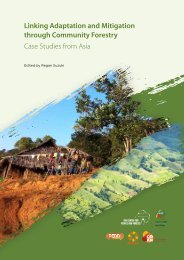Desktop Study on - Regional Climate Change Adaptation ...
Desktop Study on - Regional Climate Change Adaptation ...
Desktop Study on - Regional Climate Change Adaptation ...
Create successful ePaper yourself
Turn your PDF publications into a flip-book with our unique Google optimized e-Paper software.
Assessment of Capacity Gaps and Needs of South East Asia Countries<br />
in Addressing Impacts, Vulnerability and Adaptati<strong>on</strong> to <strong>Climate</strong> Variability and <strong>Climate</strong> <strong>Change</strong><br />
lake c<strong>on</strong>diti<strong>on</strong>, the lake serves as <strong>on</strong>e of the richest<br />
sources of freshwater fish in the world (ibid).<br />
Socio-Ec<strong>on</strong>omic Status<br />
Cambodia is <strong>on</strong>e of the least developed countries<br />
(LDC). The country’s GDP per capita of the year 2007<br />
amounts to US$ 598 and the literacy rate of total<br />
populati<strong>on</strong> over 15 is 74% (UN data, 2009). The<br />
agricultural, industrial and service sector accounted<br />
for 29%, 30% and 41% of GDP respectively in 2007<br />
(CIA, 2009). Agricultural producti<strong>on</strong> is affected by<br />
the flooding and recessi<strong>on</strong> of the Tônlé Sap Lake and<br />
the Mek<strong>on</strong>g River, which brings fertile alluviums to<br />
the central plains (Royal Government of Cambodia,<br />
2006).<br />
Cambodia’s populati<strong>on</strong> of 2007 was 14,444,000, of<br />
which approximately 80 percent lived in rural areas<br />
(UN data, 2009). Meanwhile, those who have access<br />
to improved drinking water sources in rural areas<br />
amounted to <strong>on</strong>ly 35% of total populati<strong>on</strong> in 2004<br />
(WHO and UNICEF, 2006c). Furthermore, 35% of the<br />
populati<strong>on</strong> lived below the poverty line in 2004 (UN<br />
data, 2009).<br />
<strong>Climate</strong> Risks<br />
The Cambodia-specific climate profile including<br />
current climatic c<strong>on</strong>diti<strong>on</strong>s and projected climate<br />
scenarios are briefly explained as background<br />
informati<strong>on</strong> to address vulnerability and adaptati<strong>on</strong><br />
issues.<br />
Current Climatic C<strong>on</strong>diti<strong>on</strong>s<br />
Cambodia has a characteristic tropical m<strong>on</strong>so<strong>on</strong><br />
climate with a dry seas<strong>on</strong> from mid November to<br />
mid May and a rainy seas<strong>on</strong> from mid May to mid<br />
November (Royal Government of Cambodia, 2006).<br />
The annual average temperature is 27°C, and it rises<br />
up to 38°C in April or May and falls to a minimum<br />
of 14°C in January or December. The average annual<br />
rainfall is about 1,400 mm <strong>on</strong> the central plain, and it<br />
increases to as much as 3,800 mm in the mountains<br />
and al<strong>on</strong>g the coast (Royal Government of Cambodia,<br />
2009).<br />
The natural disasters in Cambodia from the period<br />
of 1980 through 2009 are summarised in the Table<br />
13, including the type of natural disasters, the<br />
total number of incidents and people affected, and<br />
ec<strong>on</strong>omical damages generated by each incident.<br />
Flood is the major natural disaster in Cambodia that<br />
endangers people’s lives.<br />
<strong>Climate</strong> Projecti<strong>on</strong>s<br />
Cambodia is expected to experience the increase<br />
in temperatures and precipitati<strong>on</strong>, possibly with<br />
m<strong>on</strong>so<strong>on</strong> seas<strong>on</strong>s wetter and less rainfall in the dry<br />
seas<strong>on</strong> (Hoanh et al., 2003, Snidv<strong>on</strong>gs et al., 2003,<br />
Ruosteenoha et al., 2003 cited in Roth, 2009). The<br />
study for the 4th IPCC Assessment dem<strong>on</strong>strates<br />
the detailed projecti<strong>on</strong>s of temperature rise by 0.7<br />
to 2.7°C by 2060s and the increase in mean annual<br />
rainfall mainly resulted from wetter rainy seas<strong>on</strong>s<br />
(-11 to +31%) and partially due to offset by drier<br />
Table_12 Cambodia country profile<br />
overview<br />
Country level informati<strong>on</strong> (UNdata 2009, CIA 2009, WHO<br />
/ UNICEF 2006, Nati<strong>on</strong>al Institute of Statistics, 2008,<br />
Royal Government of Cambodia, 2009)<br />
Surface area (km2)<br />
Bordering countries<br />
181,035<br />
Laos PDR,<br />
Thailand, Viet<br />
Nam<br />
Populati<strong>on</strong>, 2007 (Estimated) 14,444,000<br />
Percentage of populati<strong>on</strong>, 2007 (%) in<br />
- rural areas<br />
- urban areas<br />
Populati<strong>on</strong> density, 2007 (pers<strong>on</strong>s/<br />
km2)<br />
Populati<strong>on</strong> growth rate, 2005-2010 (%<br />
per annum)<br />
79.1<br />
20.9<br />
79.8<br />
1.7<br />
Forest cover (% of total area) 53<br />
Arable land (% of total area) 20.44<br />
GDP, nominal, 2007 (milli<strong>on</strong> US$) 8,639<br />
C<strong>on</strong>tributi<strong>on</strong> of agricultural sector to<br />
GDP, 2007 (%)<br />
C<strong>on</strong>tributi<strong>on</strong> of industrial sector to<br />
GDP, 2007 (%)<br />
C<strong>on</strong>tributi<strong>on</strong> of service sector to GDP,<br />
2007 (%)<br />
Populati<strong>on</strong> below poverty line , 2004<br />
(% of total populati<strong>on</strong>)<br />
Infant mortality rate, 2005-2010 (per 1<br />
000 live births)<br />
Literacy rate, 2007 (% of total<br />
populati<strong>on</strong> over 15 that can read and<br />
write)<br />
Access to improved drinking water<br />
sources, 2004 (% of total populati<strong>on</strong>)<br />
in<br />
- rural areas<br />
- urban areas<br />
29<br />
30<br />
41<br />
35<br />
62.7<br />
74<br />
35<br />
64<br />
107

















